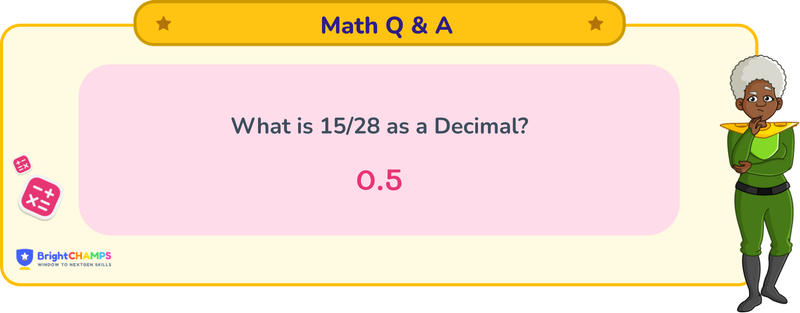Summarize this article:
 226 Learners
226 LearnersLast updated on August 5, 2025
15/28 as a Decimal

It is a simple question on decimal conversion. Firstly, we have to learn fractions and decimals. A fraction represents a part of the whole. It has two parts: the numerator (number on the top), here 15 represents how many parts out of the whole. The denominator (number below) shows how many parts make the whole, here it is 28. A decimal is a way to represent a number that is not whole, using a (.) or a decimal to separate the whole part from the fraction part. The numbers to the left of the decimal point represent the whole, and those to the right represent the fractional part.

What is 15/28 as a decimal?

Answer
15/28 as a decimal can be written as approximately 0.5357. It is a terminating decimal, which means it ends after a few digits.
Explanation
To convert 15/28 to a decimal, we will use the division method. Since 15 is smaller than 28, we will use the decimal method to perform the division. Let's see the step-by-step breakdown of the process:
Step 1: Identify the numerator and denominator because the numerator (15) will be taken as the dividend and the denominator (28) will be taken as the divisor.
Step 2: As 15 is smaller than 28, we need to convert it into a decimal form by adding a decimal point and zeros.
Step 3: We perform the division: - 28 goes into 150 five times (since 28 × 5 = 140), so we write 5 in the quotient place and subtract 140 from 150, leaving us with a remainder of 10.
Step 4: Bring down a zero, making it 100, and divide by 28. - 28 goes into 100 three times (since 28 × 3 = 84), so we write 3 in the quotient place and subtract 84 from 100, leaving a remainder of 16.
Step 5: Bring down another zero, making it 160, and divide by 28. - 28 goes into 160 five times (since 28 × 5 = 140), so we write 5 in the quotient place and subtract 140 from 160, leaving a remainder of 20.
Step 6: Bring down another zero, making it 200, and divide by 28. - 28 goes into 200 seven times (since 28 × 7 = 196), so we write 7 in the quotient place and subtract 196 from 200, leaving a remainder of 4. The division process ends here with a remainder, but since we have reached a sufficient number of decimal places for practical purposes, we can conclude the answer.
The answer for 15/28 as a decimal is approximately 0.5357.

Important Glossaries for 15/28 as a decimal
- Fraction: A numerical quantity that is not a whole number, representing a part of a whole.
- Decimal: A number that uses the base ten and includes a decimal point to separate the whole part from the fractional part.
- Numerator: The top part of a fraction, indicating how many parts of the whole are being considered.
- Denominator: The bottom part of a fraction, showing how many parts make up a whole.
- Terminating Decimal: A decimal that ends after a finite number of digits.




